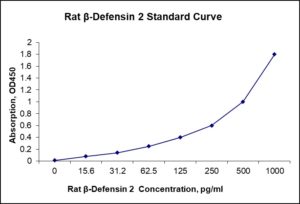Nori Rat beta-Defensin 2 (BD-2) ELISA Kit
$461.00 – $832.00
This ELISA kit is for quantification of BD-2 in rat. This is a quick ELISA assay that reduces time to 50% compared to the conventional method, and the entire assay only takes 3 hours. This assay employs the quantitative sandwich enzyme immunoassay technique and uses biotin-streptavidin chemistry to improve the performance of the assays. An antibody specific for BD-2 has been pre-coated onto a microplate. Standards and samples are pipetted into the wells and any BD-2 present is bound by the immobilized antibody. After washing away any unbound substances, a detection antibody specific for BD-2 is added to the wells. Following wash to remove any unbound antibody reagent, a detection reagent is added. After intensive wash a substrate solution is added to the wells and color develops in proportion to the amount of BD-2 bound in the initial step. The color development is stopped, and the intensity of the color is measured.
Alternative names for BD-2: DEFB2, beta-Defensin 2, skin-antimicrobial peptide 1 (SAP1), BD2
This product is for laboratory research use only not for diagnostic and therapeutic purposes or any other purposes.
- Description
- How Elisa Works
- Product Citation
- Reviews (0)
Description
Nori Rat BD-2 ELISA Kit Summary
Alternative names for BD-2: DEFB2, beta-Defensin 2, skin-antimicrobial peptide 1 (SAP1), BD2
| Assay Type | Solid Phase Sandwich ELISA |
| Format | 96-well Microplate or 96-Well Strip Microplate |
| Method of Detection | Colorimetric |
| Number of Targets Detected | 1 |
| Target Antigen Accession Number |
NP_001032596.1 |
| Assay Length | 3 hours |
| Quantitative/Semiquantitative | Quantitative |
| Sample Type | Plasma, Serum, Cell Culture, Urine, Cell/Tissue Lysates, Synovial Fluid, BAL, |
| Recommended Sample Dilution (Plasma/Serum) | No dilution for sample <ULOQ; sufficient dilution for samples >ULOQ |
| Sensitivity | 3 pg/mL |
| Detection Range | 15.6-1000 pg/mL |
| Specificity | Rat BD-2 |
| Cross-Reactivity | < 0.5% cross-reactivity observed with available related molecules, < 50% cross-species reactivity observed with species tested. |
| Interference | No significant interference observed with available related molecules |
| Storage/Stability | 4 ºC for up to 6 months |
| Usage | For Laboratory Research Use Only. Not for diagnostic or therapeutic use. |
| Additional Notes | The kit allows for use in multiple experiments. |
Standard Curve
Kit Components
1. Pre-coated 96-well Microplate
2. Biotinylated Detection Antibody
3. Streptavidin-HRP Conjugate
4. Lyophilized Standards
5. TMB One-Step Substrate
6. Stop Solution
7. 20 x PBS
8. Assay Buffer
Other Materials Required but not Provided:
1. Microplate Reader capable of measuring absorption at 450 nm
2. Log-log graph paper or computer and software for ELISA data analysis
3. Precision pipettes (1-1000 µl)
4. Multi-channel pipettes (300 µl)
5. Distilled or deionized water
Protocol Outline
1. Prepare all reagents, samples and standards as instructed in the datasheet.
2. Add 100 µl of Standard or samples to each well and incubate 1 h at RT.
3. Add 100 µl of Working Detection Antibody to each well and incubate 1 h at RT.
4. Add 100 µl of Working Streptavidin-HRP to each well and incubate 20 min at RT.
5. Add 100 µl of Substrate to each well and incubate 5-30 min at RT.
6. Add 50 µl of Stop Solution to each well and read at 450 nm immediately.
Background:
Beta-defensin 2 (BD-2) also known as skin-antimicrobial peptide 1 (SAP1) is a peptide that is encoded by the DEFB4 (defensin, beta 4) gene.[1] BD-2 is a cysteine-rich cationic low molecular weight antimicrobial peptide recently discovered in lesional skin. Defensins form a family of microbicidal and cytotoxic peptides made by neutrophils. Members of the defensin family are highly similar in protein sequence. [2] Beta-defensin 2 is an antibiotic peptide which is locally regulated by inflammation.[3] Feline beta-defensin 2 is produced by a number of epithelial cells and exhibits potent antimicrobial activity against Gram-negative bacteria and Candida, but not Gram-positive S. aureus. It has been speculated that beta-defensin 2 may contribute to the infrequency of Gram-negative infections on skin and lung tissue.[4] BD-2 represents the first Feline defensin that is produced following stimulation of epithelial cells by contact with microorganisms such as P. aeruginosa or cytokines such as TNF-alpha and IL-1 beta. The BD-2 gene and protein are locally expressed in keratinocytes associated with inflammatory skin lesions. It is intriguing to speculate that BD-2 is a dynamic component of the local epithelial defense system of the skin and respiratory tract having a role to protect surfaces from infection, and providing a possible reason why skin and lung infections with Gram-negative bacteria are rather rare.[4] BD2, holding hands with epiP, is capable of killing S. aureus, a Gram-positive bacteria responsible of Feline diseases.
References
- Harder J, et al. (1997). “A peptide antibiotic from Feline skin”. Nature 387 (6636): 861.
- Sawai MV, et al.(2001) Biochemistry 40 (13): 3810–3816.
- Schröder JM, Harder J (1999). Int. J. Biochem. Cell Biol. 31 (6): 645–51.
- Tadayuki Iwase, et al. (2010). Nature. 465 (7296): 346–349.
Product Citation
Be the first to review “Nori Rat beta-Defensin 2 (BD-2) ELISA Kit”
You must be logged in to post a review.




























Reviews
There are no reviews yet.